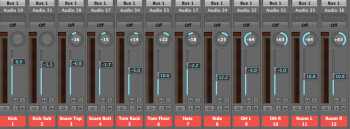In the last installment, I gave you an overview of the mixing method I'll be presenting in the upcoming articles. In that workflow, one of the first things you need to do is create a rough mix, and in this article, we'll focus on doing just that.
Why?
The rough mix is a quick mix done exclusively with the help of the volume faders and pan knobs of the tracks. This task is far from being trivial, because the rough mix will serve as the foundation for all elements to fall into place. It’s like the framework making up the skeleton of your mix/puzzle.
It’s only after you have set up this framework that you’ll have a more refined overview of things and be able to linger on the details that need fine-tuning. Would you believe me if I told you that, to me, the rough mix easily accounts for 50% of a good mix? And it is precisely at this stage where things start to go downhill for beginners…
Generally speaking, several phenomena stack up. First off, newbies tend to linger on things and intellectualize about them in excess, when it is better to let your instinct drive you. In fact, first impressions are often the best, so why rack your brains and lose your precious time for nothing? You have a goal and you are aware of it, it’s there, deep inside you, so trust your instincts!
The second phenomenon is even more incomprehensible and counterproductive. After beating his/her brains out, the aspiring sound engineer inevitably ends up doing things out of habit! Guitars are always on the same side, the relative levels between the snare and bass drum are always the same, etc. Whatever the song, it’s always done mechanically. This is a bad habit that gets in the way of your creativity, and can make your mixes a lot less interesting. Each song is different and, as such, it deserves a particular treatment and attention.
Last, but not least, beginners tend to bring out the heavy artillery right away. EQ, compressor, gate, you name it, anything you can think of supposed to solve “problems, ” while the groundwork is still not done. It’s unfortunately human to want everything right away. But that’s not how things work in reality. You need to go step by step to reach the goal you’ve set. Using a legion of plug-ins when the rough mix isn’t finished is just shooting yourself in the foot, period.
To sum it up, the rough mix is essential to a good mix and if you can hold your horses, I guarantee that this stage won’t take you more than half an hour.
How?
Personally, I have a very particular way of doing things. I start off by panning the tracks. Why? Quite simply so that my panning decisions won’t be influenced by the relative level of the tracks.
Once done, I switch to mono and take care of the volume faders. Why in mono, you ask? Well, once again, to not get distracted by the panning I just did.
In the next installment I’ll let you into the details of a fun and incredibly effective way to deal with panning your tracks in less than fifteen minutes. But before that, I invite you to take a look at one of our previous articles concerning the laws of panning, as a sort of introduction to the topic.




